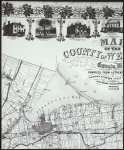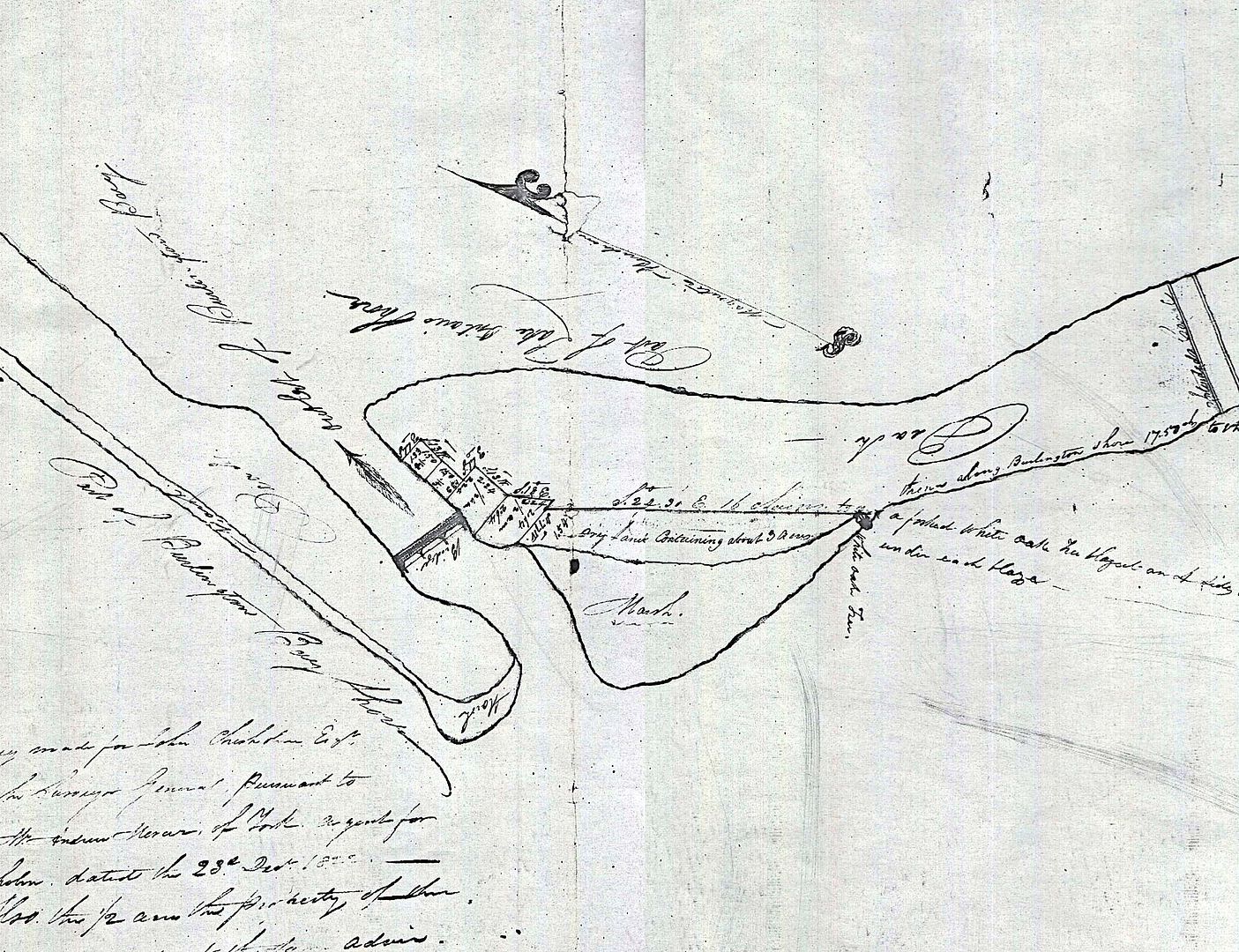The First Ferry Across Burlington Canal; The Swing Bridge And The Old Ship Inn
The Burlington Gazette
October 30th, 1957
The funeral of the late Mrs. Shaw, as It passed over the B.B. Canal, a few days ago brought to mind the few survivors of the early days of the Beach, reminiscences of things connected with that locality of more than seventy years ago. Mrs. Shaw had passed her childhood at the canal (1828 onward). Her father, Philip Magee, like many other adventurers, was attracted to the great work of opening a passage for vessels through the sand bar which separated the hay from the lake.
"Philip" as he was familiarly known, was a steady, Industrious Irishman, and took the opportunity of opening near the works a small boarding house, which soon became known as the Ship Inn. A fine picture of a full-rigged ship was kept hanging over the bar at which we poor boys of the day gazed with blank wonderment. Sailors were also attracted by the name, the picture and whiskey, which went cheerily hand in hand. Philip lost no opportunity of turning an honest penny. He kept the ferry when the excavation had advanced as far as to make a ferry necessary. This ferry was of very simple construction.
30-Foot Scow
A scow about thirty feet in length and say three feet in depth, without dock, and having long sloping ends to allow teams to he driven Into it, made up the outfit with the addition of a line stretched from side to side. by which the scow was hauled over. As the length of the scow was about half the width of the canal. 72 feet, no great effort was required to work It.
Drowning accidents were not infrequent. One of the most singular was the backing off the ferry scow of a team of horses attached to a wagon. In which sat a man and his wife. Before sufficient assistance could reach them all were drowned, and as everything that could float drifted away with the current, a bundle came near a schooner tied up in the canal, when a sailor hastily caught up a spear and was about to throw it at the mysterious object, but changing his mind, he took a boat and to his amazement picked up a sleeping infant thickly swathed in flannels rocked on the ripples of the moving waters. Now, Philip, in order to lose no time, and being a shoemaker by trade, set up a small stall In a corner of the ferry scow and devoted his spare time to the practice of the heeling art. As boots and shoes ground out fast in the sand and water, Philip captured many a snug dollar In addition to his pay for running the ferry.
He prospered. The Ship Inn was enlarged, and he also built a small schooner of about 80 tons and named it Daniel O'Connell. who had been recently elected M.P. for County of Clare, Ireland. After the Canal was completed and business became dull he sold his schooner for about $3.000, and lived a lonesome life for several years, and was ultimately frozen to death while crossing the Bay on the Ice. The Perry House now stands on the site of the noted Ship Inn.
Canal Cribs
If tales of the Beach do not tire, I may add a few items connected with the times mentioned. When the canal cribs were sufficiently advanced to admit of the mounting of a swinging bridge, one, Nathan Goodall, was engaged to construct one fit for the ordinary travel, in which he succeeded so well that it lasted a number of years or until the canal was enlarged, when a scow ferry was again adopted.
This bridge, the small end of which crossed a span of seventy two feet, was light and strong, and could be swung, in ordinary weather by one man. The long end tapered from the turntable to a small size to the excanal; while the land, or opposite end was weighted with a large oak treme end, which reached across the timbers, Increasing in size outward from the pivot, and overlapping each other as the three layers of timber were built up on either side.
Prominent Contractors
Over the pivot, and on a line with the sides of the bridge, were two strong posts, with a cross beam on which rested several long Iron pulling braces, with turnbuckles reaching to different parts of the bridge. In connection with the construction of the canal, I must not omit to mention a few prominent names; Mann & Spohn, Contractors, Henry Lutz, assistant to Nathan Goodall, S. B. Goss, and Tom Kilday, blacksmiths, Morris Corey, lately from New Brunswick, provided most of the timber In the cribs, and Henry Van Wagner, supplied the sawn lumber. Engineer Kerr son-in-law of Chief Brant, was supposed to superintend the construction.
(The Beach, Jan. 8th, 1902).
(Editor's Note: This is one of a series of historical papers presented to Hamilton Historical Society by the late Mr. W. D. Flatt. They have been loaned to The Gazette by Mrs. V. H. Emery of Northshore Boulevard.)
The Burlington Gazette
October 30th, 1957
The funeral of the late Mrs. Shaw, as It passed over the B.B. Canal, a few days ago brought to mind the few survivors of the early days of the Beach, reminiscences of things connected with that locality of more than seventy years ago. Mrs. Shaw had passed her childhood at the canal (1828 onward). Her father, Philip Magee, like many other adventurers, was attracted to the great work of opening a passage for vessels through the sand bar which separated the hay from the lake.
"Philip" as he was familiarly known, was a steady, Industrious Irishman, and took the opportunity of opening near the works a small boarding house, which soon became known as the Ship Inn. A fine picture of a full-rigged ship was kept hanging over the bar at which we poor boys of the day gazed with blank wonderment. Sailors were also attracted by the name, the picture and whiskey, which went cheerily hand in hand. Philip lost no opportunity of turning an honest penny. He kept the ferry when the excavation had advanced as far as to make a ferry necessary. This ferry was of very simple construction.
30-Foot Scow
A scow about thirty feet in length and say three feet in depth, without dock, and having long sloping ends to allow teams to he driven Into it, made up the outfit with the addition of a line stretched from side to side. by which the scow was hauled over. As the length of the scow was about half the width of the canal. 72 feet, no great effort was required to work It.
Drowning accidents were not infrequent. One of the most singular was the backing off the ferry scow of a team of horses attached to a wagon. In which sat a man and his wife. Before sufficient assistance could reach them all were drowned, and as everything that could float drifted away with the current, a bundle came near a schooner tied up in the canal, when a sailor hastily caught up a spear and was about to throw it at the mysterious object, but changing his mind, he took a boat and to his amazement picked up a sleeping infant thickly swathed in flannels rocked on the ripples of the moving waters. Now, Philip, in order to lose no time, and being a shoemaker by trade, set up a small stall In a corner of the ferry scow and devoted his spare time to the practice of the heeling art. As boots and shoes ground out fast in the sand and water, Philip captured many a snug dollar In addition to his pay for running the ferry.
He prospered. The Ship Inn was enlarged, and he also built a small schooner of about 80 tons and named it Daniel O'Connell. who had been recently elected M.P. for County of Clare, Ireland. After the Canal was completed and business became dull he sold his schooner for about $3.000, and lived a lonesome life for several years, and was ultimately frozen to death while crossing the Bay on the Ice. The Perry House now stands on the site of the noted Ship Inn.
Canal Cribs
If tales of the Beach do not tire, I may add a few items connected with the times mentioned. When the canal cribs were sufficiently advanced to admit of the mounting of a swinging bridge, one, Nathan Goodall, was engaged to construct one fit for the ordinary travel, in which he succeeded so well that it lasted a number of years or until the canal was enlarged, when a scow ferry was again adopted.
This bridge, the small end of which crossed a span of seventy two feet, was light and strong, and could be swung, in ordinary weather by one man. The long end tapered from the turntable to a small size to the excanal; while the land, or opposite end was weighted with a large oak treme end, which reached across the timbers, Increasing in size outward from the pivot, and overlapping each other as the three layers of timber were built up on either side.
Prominent Contractors
Over the pivot, and on a line with the sides of the bridge, were two strong posts, with a cross beam on which rested several long Iron pulling braces, with turnbuckles reaching to different parts of the bridge. In connection with the construction of the canal, I must not omit to mention a few prominent names; Mann & Spohn, Contractors, Henry Lutz, assistant to Nathan Goodall, S. B. Goss, and Tom Kilday, blacksmiths, Morris Corey, lately from New Brunswick, provided most of the timber In the cribs, and Henry Van Wagner, supplied the sawn lumber. Engineer Kerr son-in-law of Chief Brant, was supposed to superintend the construction.
(The Beach, Jan. 8th, 1902).
(Editor's Note: This is one of a series of historical papers presented to Hamilton Historical Society by the late Mr. W. D. Flatt. They have been loaned to The Gazette by Mrs. V. H. Emery of Northshore Boulevard.)



